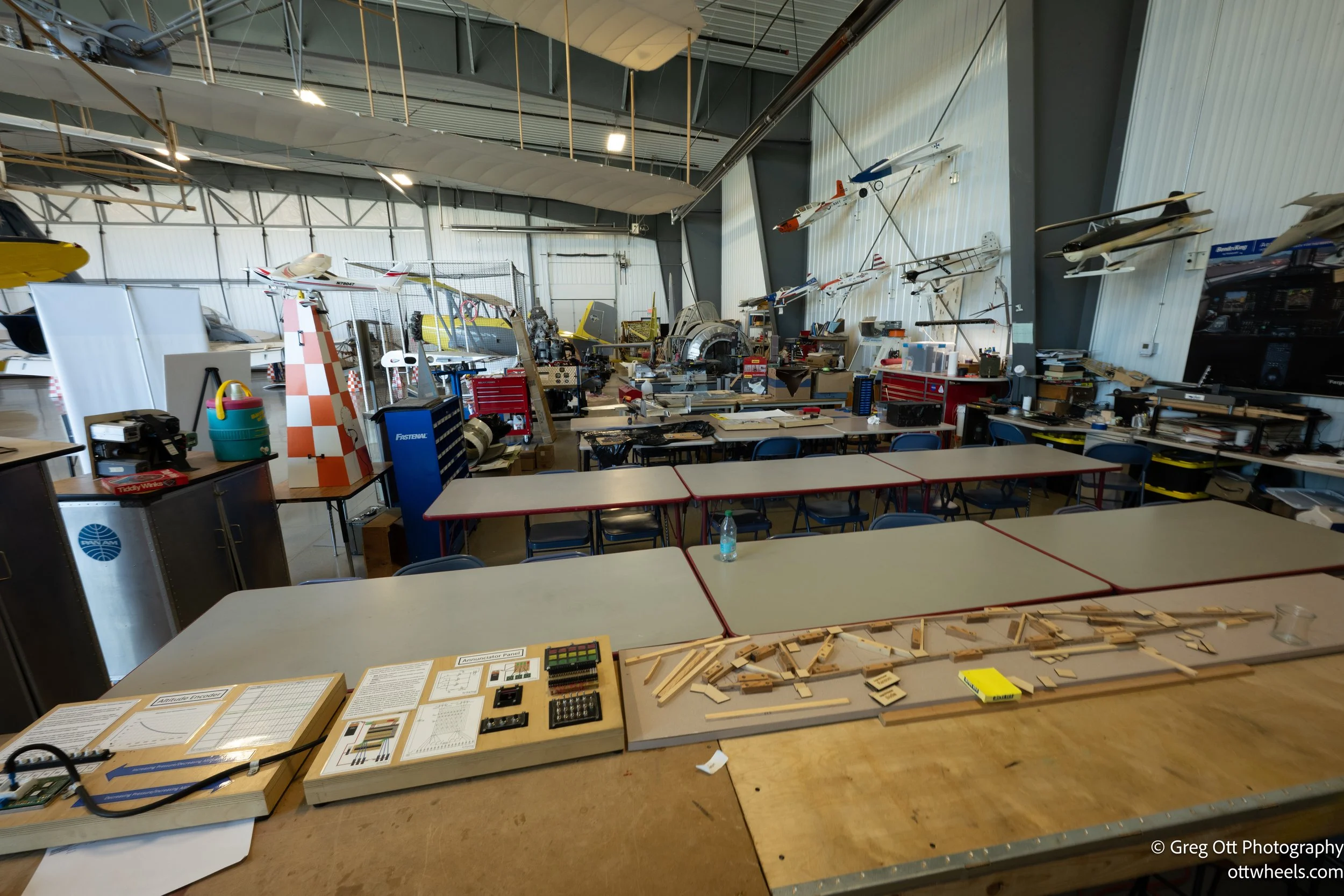Fargo, ND
I left Alexandria, MN, in the pouring rain, but the closer I got to Fargo, the more the skies began to clear. By the time I arrived, patches of blue sky had broken through with puffy white clouds scattered around.
My first stop was the North Dakota Visitors Center. The two women at the counter were incredibly helpful, asking me to share my full 14-day itinerary. For each stop I mentioned, they either pulled a brochure from the racks or handed me one directly, adding helpful details as they went. It was the kind of genuine assistance that makes you feel welcome in a new state.
Out front, I noticed a small crowd laughing and taking photos. A man asked a stranger to snap a shot of him while his wife laid down dramatically in front of what I thought were lights embedded in the ground. Then I realized what was going on. They were acting out the infamous woodchipper scene from the Coen brothers’ movie Fargo.
The city has leaned all the way into its Hollywood claim to fame. Right outside the Visitors Center sits a bright yellow wood chipper, complete with a mannequin leg sticking out. Sometimes staff add scarves or props so visitors can pose for their own darkly comic reenactments. Inside, there’s memorabilia from the film, but the chipper itself is clearly the star attraction. What could have been a quirky footnote has become one of North Dakota’s most photographed roadside oddities.
Before hitting the museums, I made a quick stop at Planet Fitness for a shower. This location felt almost brand-new—spotless and nearly empty. PF gyms usually need a larger population base to thrive, which you don’t find in much of northern Minnesota, so it felt like a small luxury to have one here. A quiet reset before continuing my day.
Plains Art Museum
The Plains Art Museum in downtown Fargo focuses on connecting art, artists, and audiences through exhibitions, education, and community programs. Founded in 1965 as the Red River Art Center in Moorhead, it moved in 1997 to a renovated warehouse in Fargo, where it now holds a permanent collection of over 4,000 works. During my visit, though, much of the space felt empty, with only the second floor featuring exhibits. I found myself enjoying the view from the third-floor windows—something another visitor pointed out to me as well.
Anne Labovitz
One of the most striking works in the Plains Art Museum is Anne Labovitz’s installation Convergence: Health & Creativity. A plaque beside the piece explains that it was inspired by Labovitz’s research into the psychological benefits of art, specifically how creativity supports well-being. Known for her gestural, colorful, and emotive mark-making, Labovitz created Convergence as both a visual and experiential response to the museum’s architecture. The work incorporates five central themes—Hope, Love, Resilience, Rest, and Community—which she developed through interviews with healthcare professionals, community groups, and individuals in the Fargo-Moorhead area. The installation not only reflects her broader artistic practice—where color, light, and human connection are always at the forefront—but also roots itself in the lived experiences of the people she collaborated with.
The sculpture is made of 380 feet of painted Tyvek, suspended so visitors can view it from all three floors. Its translucency lets natural light animate the colors—reds and purples shifting to blues and silvers that echo night skies and nod to James Rosenquist’s The North Dakota Mural. I spent time photographing it, even experimenting with intentional camera movement, but no still image quite captured how alive it feels as light transforms it throughout the day.
Second Floor
When I reached the second floor of the Plains Art Museum, I found the real activity of my visit. Two main exhibitions were on display: one highlighting the career of Murray Lemley and the other, Ghost Writing, a mid-career retrospective of Jaque Fragua. The contrast between the two gave the floor a balance—one reflecting on a long career behind the lens, the other projecting a contemporary Native voice in bold, experimental ways.
Murray Lemley, a North Dakota native, is a photographer whose work extends far beyond the Midwest. The exhibit featured images from Paris, Venice, Vienna, and other cities, alongside scenes closer to home. His photographs linger on architecture, light, and the textures of place, whether it’s the fading detail of a North Dakota grain elevator or the ornate façade of a European street. Seen together, his body of work showed a careful eye for composition and a fascination with how environments—both local and global—reveal themselves through time.
Jaque Fragua’s Ghost Writing brought a very different energy. A Native artist from Jemez Pueblo, New Mexico, Fragua works across painting, sculpture, and street art, often blending spray-paint aesthetics with Indigenous themes. His pieces in Fargo layered bold color, text, and imagery in ways that felt both modern and ancestral. They challenged conventional museum spaces while asserting Native presence and resilience. The show was vibrant, unapologetic, and carried an urgency that contrasted with Lemley’s slower, more contemplative vision.
Fargo Air Museum
The Fargo Air Museum doubled as a Harvest Host, so I put in a request to stay overnight. While waiting for confirmation, I swung by CVS—one of only six in the entire state—to fill a prescription. Then I headed back to the museum.
At the desk, the staff weren’t sure yet about my request. They mentioned a few RVs were already booked for the night, but they said they’d check and let me know. With that, I bought a ticket and started exploring.
The museum covers two hangars packed with history. Most of the aircraft aren’t just shells on display—they’re restored and in many cases still airworthy. Standing inches from polished cockpits and engines gave the place an energy I don’t always feel at bigger museums. Exhibits ranged from World War II fighters to postwar trainers and civilian planes, with special sections honoring North Dakotans who served in aviation. An exhibition on Hector Field discussed the local airport’s history. There was an area for the USS Fargo, a WWII ship. Another corner paid tribute to the Blue Angels, complete with photos and memorabilia from their Fargo visits. Perhaps, my favorite was the B-25 sitting below a Swiss flag. I tried to see how many flags I recognized, which was only about half of them.
Above and Beyond
The museum also featured Above and Beyond, a powerful memorial to the Vietnam War. The installation suspends 58,307 dog tags—one for each American service member killed—hand-stamped and arranged to fill the space with a haunting sense of scale and loss. It’s an exhibit that stops you in your tracks and stays with you long after you leave.
Toward the back, I found an education area set up with workbenches, materials, and displays for teaching kids (and adults) about flight and restoration. It was quiet that day, but you could tell it’s used regularly.
Midway through my visit, the young man who checked me in earlier tracked me down to say my overnight request had been approved. That settled the question of where I’d sleep, and I relaxed into the exhibits. I spent nearly two hours wandering through the displays before stepping outside into the late-afternoon sun, ready to head downtown for dinner.
Downtown Fargo
Downtown Fargo surprised me. I expected quiet streets, but instead I found a lively food scene, buzzing sidewalks, and plenty of neon. The Fargo Theatre marquee is the most iconic, but it’s far from the only one. Broadway is dotted with glowing signs—restaurants, bars, and boutiques that give the district a vintage yet modern energy. Even side streets lit up with murals and string lights that gave the evening a casual, welcoming feel.
I stopped at Blackbird Woodfire Pizza, which had excellent reviews. I ordered their gorgonzola, walnut, and grape pizza along with a fresh side salad and a local craft beer. The pizza came out thin and crispy with a true Italian-style crust, balanced perfectly by the sharp cheese and sweet grapes. The salad was small but fresh, and the beer rounded it out. It was one of those meals that makes you think, “Yeah, I’d come back here again.”
Art Alley
Just a few blocks from Broadway sits Art Alley, Fargo’s officially designated street-art space since 2015. Murals here are constantly changing, layers of color and messages building on one another as new artists add their work. Some pieces are polished, others raw and experimental, but that’s the point—no two visits are alike.
When I stopped by, two young women, Chloe and Nevaeh, were spray-painting a section of wall. We got to talking. Chloe was studying engineering at NDSU, and Nevaeh was still in high school. Nevaeh told me her name is simply “Heaven” spelled backward—a name that rose in popularity after Sonny Sandoval of the band P.O.D. introduced his daughter on MTV Cribs back in 2000. They were smart, curious, and full of energy, and before long we were talking about art, photography, and Fargo itself.
In a strange twist, when I showed Chloe my blog, she scrolled to a photo of an old house I’d taken in Minnesota. She and Nevaeh instantly recognized it—they’d seen it too. Proof that certain landmarks draw people in again and again.
As they headed out, they offered me their leftover spray paint. I declined, but they passed the cans to two other women who had just arrived, Aubrey and Dare, who started painting colorful hearts. I nicknamed them the “Heart Ladies.” The alley was alive with layers of paint, conversation, and creativity.
I also chatted with Jack, an Ojibwe and French Fargo resident who spoke openly about culture, poverty, and the challenges of preserving Native traditions. Conversations like these reminded me that Art Alley isn’t just a wall—it’s a meeting ground. Between events like Can Jam, where anyone can grab a can and contribute, and the everyday artists who stop by, it has become one of Fargo’s most dynamic cultural spots.
By the time I wandered back to Broadway, I knew nothing else I’d see that night would top Art Alley. I returned to the Air Museum, parked the van, and settled in for the night after a full, unexpected, and memorable day in Fargo.


















































